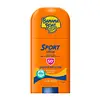What's inside
What's inside
 Key Ingredients
Key Ingredients

 Benefits
Benefits

 Concerns
Concerns

 Ingredients Side-by-side
Ingredients Side-by-side

Titanium Dioxide 8%
Cosmetic ColorantZinc Oxide 10%
Cosmetic Colorant1,2-Hexanediol
Skin ConditioningAloe Barbadensis Leaf Juice Powder
Skin ConditioningAlumina
AbrasiveAluminum Stearate
Cosmetic ColorantButyloctyl Salicylate
Skin ConditioningC12-15 Alkyl Benzoate
AntimicrobialCaprylyl Glycol
EmollientCetyl Dimethicone
EmollientCetyl PEG/PPG-10/1 Dimethicone
EmulsifyingDimethicone
EmollientDisodium EDTA
Ethylhexyl Palmitate
EmollientEthylhexyl Stearate
EmollientEuphorbia Cerifera Wax
Hexyl Laurate
EmollientHydroxyacetophenone
AntioxidantMethyl Glucose Dioleate
EmollientOctyldodecyl Neopentanoate
EmollientPEG-7 Hydrogenated Castor Oil
EmulsifyingPolyglyceryl-4 Isostearate
EmulsifyingPolyhydroxystearic Acid
EmulsifyingPropanediol
SolventTocopherol
AntioxidantTocopheryl Acetate
AntioxidantTriethoxycaprylylsilane
Trimethylsiloxysilicate
EmollientVp/Hexadecene Copolymer
Water
Skin ConditioningTitanium Dioxide 8%, Zinc Oxide 10%, 1,2-Hexanediol, Aloe Barbadensis Leaf Juice Powder, Alumina, Aluminum Stearate, Butyloctyl Salicylate, C12-15 Alkyl Benzoate, Caprylyl Glycol, Cetyl Dimethicone, Cetyl PEG/PPG-10/1 Dimethicone, Dimethicone, Disodium EDTA, Ethylhexyl Palmitate, Ethylhexyl Stearate, Euphorbia Cerifera Wax, Hexyl Laurate, Hydroxyacetophenone, Methyl Glucose Dioleate, Octyldodecyl Neopentanoate, PEG-7 Hydrogenated Castor Oil, Polyglyceryl-4 Isostearate, Polyhydroxystearic Acid, Propanediol, Tocopherol, Tocopheryl Acetate, Triethoxycaprylylsilane, Trimethylsiloxysilicate, Vp/Hexadecene Copolymer, Water
Butyl Methoxydibenzoylmethane 2.7%
UV AbsorberHomosalate 9%
Skin ConditioningEthylhexyl Salicylate 4.5%
UV AbsorberOctocrylene 9%
UV AbsorberOzokerite
Emulsion StabilisingCaprylic/Capric Triglyceride
MaskingEthylhexyl Palmitate
EmollientDiisopropyl Adipate
EmollientCetyl Alcohol
EmollientTheobroma Cacao Seed Butter
EmollientDimethicone
EmollientPEG-8
HumectantCaprylyl Glycol
EmollientSilica
AbrasiveLauryl PEG-8 Dimethicone
Methyl Dihydroabietate
Phenylisopropyl Dimethicone
Skin ConditioningPolyglyceryl-3 Stearate/Isostearate/Dimer Dilinoleate Crosspolymer
HumectantButyl Methoxydibenzoylmethane 2.7%, Homosalate 9%, Ethylhexyl Salicylate 4.5%, Octocrylene 9%, Ozokerite, Caprylic/Capric Triglyceride, Ethylhexyl Palmitate, Diisopropyl Adipate, Cetyl Alcohol, Theobroma Cacao Seed Butter, Dimethicone, PEG-8, Caprylyl Glycol, Silica, Lauryl PEG-8 Dimethicone, Methyl Dihydroabietate, Phenylisopropyl Dimethicone, Polyglyceryl-3 Stearate/Isostearate/Dimer Dilinoleate Crosspolymer
 Reviews
Reviews

Ingredients Explained
These ingredients are found in both products.
Ingredients higher up in an ingredient list are typically present in a larger amount.
Caprylyl Glycol is a humectant and emollient, meaning it attracts and preserves moisture.
It is a common ingredient in many products, especially those designed to hydrate skin. The primary benefits are retaining moisture, skin softening, and promoting a healthy skin barrier.
Though Caprylyl Glycol is an alcohol derived from fatty acids, it is not the kind that can dry out skin.
This ingredient is also used as a preservative to extend the life of products. It has slight antimicrobial properties.
Learn more about Caprylyl GlycolDimethicone is a type of synthetic silicone created from natural materials such as quartz.
What it does:
Dimethicone comes in different viscosities:
Depending on the viscosity, dimethicone has different properties.
Ingredients lists don't always show which type is used, so we recommend reaching out to the brand if you have questions about the viscosity.
This ingredient is unlikely to cause irritation because it does not get absorbed into skin. However, people with silicone allergies should be careful about using this ingredient.
Note: Dimethicone may contribute to pilling. This is because it is not oil or water soluble, so pilling may occur when layered with products. When mixed with heavy oils in a formula, the outcome is also quite greasy.
Learn more about DimethiconeEthylhexyl Palmitate, also known as octyl palmitate, is created from 2-ethylhexyl alcohol and palmitic acid. It is a fatty acid ester.
The fatty acid content of Ethylhexyl Palmitate makes it an emollient. Emollients help soften and hydrate your skin by trapping moisture within.
Ethylhexyl Palmitate is also used to help improve the texture of cosmetics. It helps other ingredient dissolve in products and help disperse ingredients more evenly.
You'll likely find this ingredient in sunscreen, as it is often used to mix UV-blocking ingredients such as avobenzone and ethylhexyl triazone.
It can also help stabilize the fragrances in a product as a fragrance fixative.
Ethylhexyl Palmitate can be used to substitute mineral oil.
Due to its high fatty acid content, it may not be fungal-acne safe.
Learn more about Ethylhexyl Palmitate